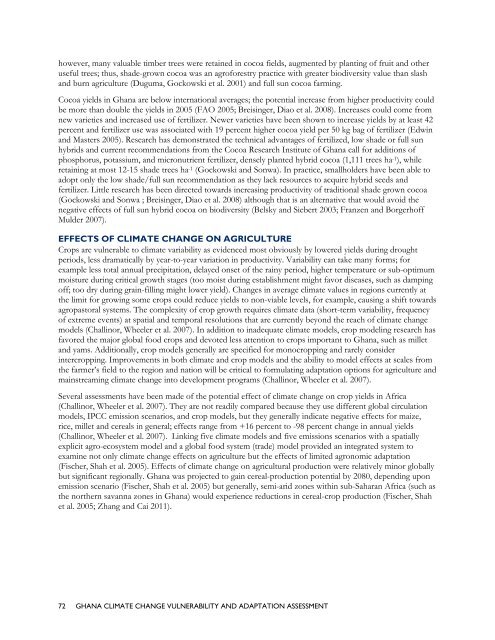ghana climate change vulnerability and adaptation assessment
ghana climate change vulnerability and adaptation assessment
ghana climate change vulnerability and adaptation assessment
- No tags were found...
You also want an ePaper? Increase the reach of your titles
YUMPU automatically turns print PDFs into web optimized ePapers that Google loves.
however, many valuable timber trees were retained in cocoa fields, augmented by planting of fruit <strong>and</strong> otheruseful trees; thus, shade-grown cocoa was an agroforestry practice with greater biodiversity value than slash<strong>and</strong> burn agriculture (Duguma, Gockowski et al. 2001) <strong>and</strong> full sun cocoa farming.Cocoa yields in Ghana are below international averages; the potential increase from higher productivity couldbe more than double the yields in 2005 (FAO 2005; Breisinger, Diao et al. 2008). Increases could come fromnew varieties <strong>and</strong> increased use of fertilizer. Newer varieties have been shown to increase yields by at least 42percent <strong>and</strong> fertilizer use was associated with 19 percent higher cocoa yield per 50 kg bag of fertilizer (Edwin<strong>and</strong> Masters 2005). Research has demonstrated the technical advantages of fertilized, low shade or full sunhybrids <strong>and</strong> current recommendations from the Cocoa Research Institute of Ghana call for additions ofphosphorus, potassium, <strong>and</strong> micronutrient fertilizer, densely planted hybrid cocoa (1,111 trees ha -1 ), whileretaining at most 12-15 shade trees ha -1 (Gockowski <strong>and</strong> Sonwa). In practice, smallholders have been able toadopt only the low shade/full sun recommendation as they lack resources to acquire hybrid seeds <strong>and</strong>fertilizer. Little research has been directed towards increasing productivity of traditional shade grown cocoa(Gockowski <strong>and</strong> Sonwa ; Breisinger, Diao et al. 2008) although that is an alternative that would avoid thenegative effects of full sun hybrid cocoa on biodiversity (Belsky <strong>and</strong> Siebert 2003; Franzen <strong>and</strong> BorgerhoffMulder 2007).EFFECTS OF CLIMATE CHANGE ON AGRICULTURECrops are vulnerable to <strong>climate</strong> variability as evidenced most obviously by lowered yields during droughtperiods, less dramatically by year-to-year variation in productivity. Variability can take many forms; forexample less total annual precipitation, delayed onset of the rainy period, higher temperature or sub-optimummoisture during critical growth stages (too moist during establishment might favor diseases, such as dampingoff; too dry during grain-filling might lower yield). Changes in average <strong>climate</strong> values in regions currently atthe limit for growing some crops could reduce yields to non-viable levels, for example, causing a shift towardsagropastoral systems. The complexity of crop growth requires <strong>climate</strong> data (short-term variability, frequencyof extreme events) at spatial <strong>and</strong> temporal resolutions that are currently beyond the reach of <strong>climate</strong> <strong>change</strong>models (Challinor, Wheeler et al. 2007). In addition to inadequate <strong>climate</strong> models, crop modeling research hasfavored the major global food crops <strong>and</strong> devoted less attention to crops important to Ghana, such as millet<strong>and</strong> yams. Additionally, crop models generally are specified for monocropping <strong>and</strong> rarely considerintercropping. Improvements in both <strong>climate</strong> <strong>and</strong> crop models <strong>and</strong> the ability to model effects at scales fromthe farmer’s field to the region <strong>and</strong> nation will be critical to formulating <strong>adaptation</strong> options for agriculture <strong>and</strong>mainstreaming <strong>climate</strong> <strong>change</strong> into development programs (Challinor, Wheeler et al. 2007).Several <strong>assessment</strong>s have been made of the potential effect of <strong>climate</strong> <strong>change</strong> on crop yields in Africa(Challinor, Wheeler et al. 2007). They are not readily compared because they use different global circulationmodels, IPCC emission scenarios, <strong>and</strong> crop models, but they generally indicate negative effects for maize,rice, millet <strong>and</strong> cereals in general; effects range from +16 percent to -98 percent <strong>change</strong> in annual yields(Challinor, Wheeler et al. 2007). Linking five <strong>climate</strong> models <strong>and</strong> five emissions scenarios with a spatiallyexplicit agro-ecosystem model <strong>and</strong> a global food system (trade) model provided an integrated system toexamine not only <strong>climate</strong> <strong>change</strong> effects on agriculture but the effects of limited agronomic <strong>adaptation</strong>(Fischer, Shah et al. 2005). Effects of <strong>climate</strong> <strong>change</strong> on agricultural production were relatively minor globallybut significant regionally. Ghana was projected to gain cereal-production potential by 2080, depending uponemission scenario (Fischer, Shah et al. 2005) but generally, semi-arid zones within sub-Saharan Africa (such asthe northern savanna zones in Ghana) would experience reductions in cereal-crop production (Fischer, Shahet al. 2005; Zhang <strong>and</strong> Cai 2011).72 GHANA CLIMATE CHANGE VULNERABILITY AND ADAPTATION ASSESSMENT
















